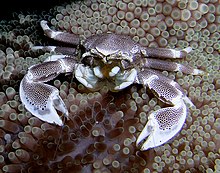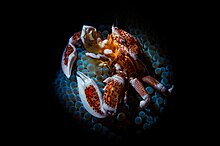| Neopetrolisthes maculatus | |
|---|---|

| |
| Scientific classification | |
| Domain: | Eukaryota |
| Kingdom: | Animalia |
| Phylum: | Arthropoda |
| Class: | Malacostraca |
| Order: | Decapoda |
| Suborder: | Pleocyemata |
| Infraorder: | Anomura |
| Family: | Porcellanidae |
| Genus: | Neopetrolisthes |
| Species: | N. maculatus |
| Binomial name | |
| Neopetrolisthes maculatus (H. Milne-Edwards, 1837) | |
| Synonyms | |
| |

Neopetrolisthes maculatus is a species of porcelain crab from the Indo-Pacific region. It is a small, colourful crustacean with a porcelain-like shell. This porcelain crab is usually found within the stinging tentacles of a number of sea anemone species.
Gallery
-
 Neopetrolisthes maculatus at Wakatobi National Park, 2015
Neopetrolisthes maculatus at Wakatobi National Park, 2015
-
 Close up of chelipeds of Neopetrolisthes maculatus, 2006
Close up of chelipeds of Neopetrolisthes maculatus, 2006
-
 Close up of Neopetrolisthes maculatus at Lembeh, Indonesia, 2016
Close up of Neopetrolisthes maculatus at Lembeh, Indonesia, 2016
-
 Chelipeds of Neopetrolisthes maculatus at Anilao, Philippines, 2014
Chelipeds of Neopetrolisthes maculatus at Anilao, Philippines, 2014
-
 Neopetrolisthes maculatus pouncing on carpet anemone, 2004
Neopetrolisthes maculatus pouncing on carpet anemone, 2004
-
 Neopetrolisthes maculatus near Sorong, Indonesia, 2015
Neopetrolisthes maculatus near Sorong, Indonesia, 2015
References
- ^ Masayuki Osawa (2012). "Neopetrolisthes maculatus (H. Milne Edwards, 1837)". WoRMS. World Register of Marine Species. Retrieved November 24, 2012.
- Masayuki Osawa & Patsy A. McLaughlin (2010). "Annotated checklist of anomuran decapod crustaceans of the world (exclusive of the Kiwaoidea and families Chirostylidae and Galatheidae of the Galatheoidea) Part II – Porcellanidae" (PDF). The Raffles Bulletin of Zoology. Suppl. 23: 109–129. Archived from the original (PDF) on 2012-03-02.
- Akira Asakura (2002). "The evolution of mating systems in decapod crustaceans" (PDF). In Joel W. Martin; Keith A. Crandall; Darryl L. Felder (eds.). Decapod Crustacean Phylogenetics. CRC Press. pp. 121–182. ISBN 978-1-4200-9258-5.
External links
 Media related to Neopetrolisthes maculatus at Wikimedia Commons
Media related to Neopetrolisthes maculatus at Wikimedia Commons- Photos of Neopetrolisthes maculatus on Sealife Collection
| Taxon identifiers | |
|---|---|
| Neopetrolisthes maculatus | |
| Porcellana maculata | |
This Anomura article is a stub. You can help Misplaced Pages by expanding it. |